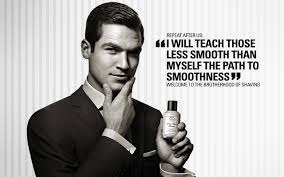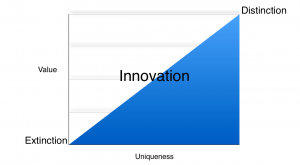Category: Observations
 Every MBA school in America will tell you the importance of a 5 year plan. You have to have a clear vision of where you are headed, where your business will be, and what it will LOOK like five years from now. How many employees, how many customers, what kind of product mix? You have to have vision.
Every MBA school in America will tell you the importance of a 5 year plan. You have to have a clear vision of where you are headed, where your business will be, and what it will LOOK like five years from now. How many employees, how many customers, what kind of product mix? You have to have vision.
Five years from now is 2020. So, do you have 2020 vision? Is it enough?
Frankly, I think the five year plan is overrated.
I’ll bet Motorola had a five year plan. So did Sears and Palm and General Motors and Eastern Airlines and they probably all had 5 year committees and strategy teams, too.
The problem with most five year plans is they often fail to take into account the most important and unpredictable factor in the equation – the customer. The customer doesn’t have a five year plan. The customer wants what she wants, when she wants it, and as soon as somebody offers her a better widget, she’s going to want that new widget. Now. Your plans be damned. Bean counters and MBAs spend countless hours plotting strategies to maximize profits, streamline performance, and increase ROI assuming the future is going to look very much like the present.
 The answer is NOT another focus group.
The answer is NOT another focus group.
Henry Ford said if he had asked his customers what they wanted, they would have said “A faster horse.” He was right of course. His five year plan was not to build a car. It was to build a better mode of personal transportation. The result was a car.
No, real visionaries aren’t looking at their balance sheet in five years, they are looking at their customers now and how they might make their lives better in five years. The companies that lead year after year are the companies that focus on innovation… creative solutions to their customers’ problems. Those companies see change happening before it happens, usually because they are creating the change. The companies that aren’t innovating see the changes too late and find their business model, as well as their five year plans, irrelevant and obsolete.
 So, if you want 2020 vision, focus on solving your customers’ problems in new and exciting ways and you’ll be surprised how clear the future becomes.
So, if you want 2020 vision, focus on solving your customers’ problems in new and exciting ways and you’ll be surprised how clear the future becomes.
The old saying goes “build a better mousetrap and the world will beat a path to your door”…implying that all you have to do is find a better way of doing something and you’ll be a successful innovator.
Not true
Lots of better solutions fail everyday and they fail for two basic reasons: #1 – They aren’t really solutions. #2 – The marketing focuses on the “new and shiny” and neglects the customer’s needs.
 Do you really want to trap mice?
Do you really want to trap mice?
Of course you don’t. The problem is NOT that you need to catch the little critters. The problem is that you don’t want them in your house at all. A truly better solution is the one that keeps the mice out in the first place. A cat, for instance, or a patch in the wall, or mouse repellant, or mouse poison are all better solutions for keeping the mice out.
True innovation gets to the root of the problem and offers a solution that is more than new and improved.  It looks at the problem from a different perspective and offers something that makes the jobs easier, faster, better, cheaper, or whatever matters most to the end user.
It looks at the problem from a different perspective and offers something that makes the jobs easier, faster, better, cheaper, or whatever matters most to the end user.
If you want to innovate in your business, you have to start with your customer’s problems. Understand them, solve them and you will find innovation. Then and only then, are you ready to go to market.
We’ll talk about how you market that innovation next time.
PS. If you really want to trap a mouse, you just can’t beat the old-fashioned, spring-loaded board with a piece of cheese.
No doubt about it, innovation is the buzzword of the decade, maybe the century. From Amazon to Zappos, innovation abounds and companies strive to emulate, replicate, and instigate it. The latest, disturbing trend is the Department of Innovation and the inevitable VP of Innovation. There are 7628 listings on Indeed.com that include the word “innovation” in the title or job description. Likewise, Linkedin.com.
What are these people thinking?
“We ne ed it. We don’t know what it is, but we gotta have it so let’s put somebody in charge of it.” I’ve heard it more times than I can count and I am convinced this may be the absolute fastest way to go out of business. An entire company will sit around waiting for the “VP of I” to hand down insights and revelations. Not even Steve Jobs could handle that kind of pressure. The greatest, most innovative companies are not led by “innovators”. They are led by people who inspire innovation while demanding excellence and focus.
ed it. We don’t know what it is, but we gotta have it so let’s put somebody in charge of it.” I’ve heard it more times than I can count and I am convinced this may be the absolute fastest way to go out of business. An entire company will sit around waiting for the “VP of I” to hand down insights and revelations. Not even Steve Jobs could handle that kind of pressure. The greatest, most innovative companies are not led by “innovators”. They are led by people who inspire innovation while demanding excellence and focus.
The truth about innovation.
Innovation doesn’t come from a department, and rarely does it spring from a single person. It comes from a commitment to problem-solving. Companies that are committed to solving their customers’ problems always find ways to innovate, sometimes by accident, sometimes on purpose. The point is, they are always looking for opportunities to innovate. 3M and Proctor and Gamble rarely make the headlines, but they get it, and that’s why they’ve excelled as long as they have.
It has to be in your culture.
So, don’t tell your team that you’ve decided to become an innovation organization. Instead, get everyone to start identifying and solving customer problems all the time. Create a culture of innovation. (Just don’t call it that.) The ideas will flow, the solutions will come, and your customers will recognize and reward the effort.
 This is a story about the little things. The little things that solve little problems that give customers what they want and bring success to the little thing innovator. Hewlett-Packard had great success with the handheld calculator but they did NOT invent the handheld calculator. That honor belongs to Texas Instruments. The first calculator was big and bulky and cost $2500.
This is a story about the little things. The little things that solve little problems that give customers what they want and bring success to the little thing innovator. Hewlett-Packard had great success with the handheld calculator but they did NOT invent the handheld calculator. That honor belongs to Texas Instruments. The first calculator was big and bulky and cost $2500.
What makes ours special? Nothing. Except…
 That was 1967. By the 70’s, Hewlett-Packard and others had knocked off the idea and the price had dropped to about $75. Bill Hewlett was talking with the ad team of Dick Orkin and Bert Berdis about an ad campaign to sell more calculators. They asked “What makes your product special?” He replied, “Nothing. They all perform the same functions. They all cost about the same. Nothing.” And then he said, “…we do have one little thing. The problem with other calculators is that they are slick on the bottom and slide across your desk when you punch the keys. We added four little rubber feet to keep ours from sliding.”
That was 1967. By the 70’s, Hewlett-Packard and others had knocked off the idea and the price had dropped to about $75. Bill Hewlett was talking with the ad team of Dick Orkin and Bert Berdis about an ad campaign to sell more calculators. They asked “What makes your product special?” He replied, “Nothing. They all perform the same functions. They all cost about the same. Nothing.” And then he said, “…we do have one little thing. The problem with other calculators is that they are slick on the bottom and slide across your desk when you punch the keys. We added four little rubber feet to keep ours from sliding.”
Orkin and Berdis sat down on the curb outside Hewlett’s office and created a radio commercial that focused on the sliding problem and the little rubber feet. Sales of H-P calculators went through the roof. Those little rubber feet didn’t add 2 cents to the cost of the product but solved a serious problem that mattered to customers. The little innovation, and the marketing that went with it, made the difference for H-P.
Every problem is an opportunity for innovation. Solve the problem, tell people about it, and you’ll be a star.
 Simon Sinek in Start With Why says innovation is revolutionary. It changes industries, changes the way we do things. According to Sinek, innovation is a BIG DEAL. He is right. And he is wrong.
Simon Sinek in Start With Why says innovation is revolutionary. It changes industries, changes the way we do things. According to Sinek, innovation is a BIG DEAL. He is right. And he is wrong.
Innovation is a big deal about 2 percent of the time. 98 percent of the time though, innovation goes unnoticed by most of the world. Most innovations are small, simple ideas that by themselves, don’t make a big difference. (more…)
 I was in Grand Rapids, Michigan, recently and “discovered” The Art of Shaving. It’s an upscale mall store that is dedicated to one thing and one thing only…the perfect shave for men. As it turns out, I could have discovered it in any one of dozens of malls nationwide. The company has been around since 1996 and its history is the perfect example of the power of innovation.
I was in Grand Rapids, Michigan, recently and “discovered” The Art of Shaving. It’s an upscale mall store that is dedicated to one thing and one thing only…the perfect shave for men. As it turns out, I could have discovered it in any one of dozens of malls nationwide. The company has been around since 1996 and its history is the perfect example of the power of innovation.
“There’s got to be a better way.”
That’s how good innovation starts. Co-founder Eric Malka said to his wife, “There’s got to be a better way to shave,” and the two of them set about finding it. Over time, they developed a four step system that lubricates, lathers, shaves, moisturizes, and turns the entire shaving ritual into something a man can actually look forward to. When I am finished shaving, my face feels so good I wish I could shave again. Sometimes I do.

Innovation is Worth More
People are willing to pay more for real solutions, especially one-of-a-kind solutions. AoS virtually owns the high-end shaving market and they get a premium for their products. This is the real value of innovation. Higher margins, better sales, and loyal customers. In 2009, Procter and Gamble (owners of Gillette) bought The Art of Shaving and the company continues to grow.
Like I said, innovation is worth more.
Innovation guru Doug Hall says that every business, every product, every service is on a continuum somewhere between Monopoly and Commodity. At one end, you own the market (for the moment) and at the other, you compete with the rest of the commodities. I think it is the difference between Distinction and Extinction. At the Distinction end of the spectrum, sales, margins, profits, market share and brand recognition are all high. At the other end, the opposite is true and when you compete on price, you never win long term. For the record, WalMart does NOT compete on price.* But that’s another post for another day.
Innovation is the difference.
Companies that offer true innovation offer unique solutions to customer problems, provide real value, and raise the bar for their industry. Innovation comes in all shapes and sizes. Some are stepping stones to larger innovations. Some (like the mouse, the mp3 player, and the touch screen) go unrealized until someone like Steve Jobs comes along. It’s not the size of the innovation that matters, it’s the relentless pursuit of innovation and the marketing of that innovation that yields results.
* A 2012 study by Bloomberg Industries showed that Target, Aldi, even Kroger, had better prices on many products.
 Thought Leadership may be the fastest growing “sub-industry” in the world. There are over 150 million blogs covering every subject under the sun. Everyone is clamoring to be THE Thought Leader in their respective fields. (Including yours truly, of course.)
Thought Leadership may be the fastest growing “sub-industry” in the world. There are over 150 million blogs covering every subject under the sun. Everyone is clamoring to be THE Thought Leader in their respective fields. (Including yours truly, of course.)
While thought leadership is good, it can also be a trap.
In a popular 1960’s TV show “The Many Loves of Dobie Gillis” the hapless hero, Dobie would find himself in the shadow of The Thinker statue while he contemplated his life. Week after week, he “thought”. Week after week, his life, his love, his troubles remained the same. He never changed. This happens a lot in business. We think, we study, we assign committees, we study some more…..
Be a Change Leader.
Companies that are change leaders are as much about doing as thinking. They actively search for problems to solve…their problems and their customers’ problems. When they solve one problem, they quickly move on to the next. Like a shark, they never stop moving. They never stop changing and innovating. Never. Companies that look for stability or equilibrium soon find themselves falling behind the change leaders. They start to look for ways to “save” rather than ways to “make”. And as my friend Chuck Verrett often says, “you can’t cut your way to success”. Once they start down the path of cost cutting and price cutting, they soon become a commodity, margins shrink, sales shrink, customers leave. Ironically, they stop providing the quality and service that made them successful in the first place.
Opportunity is everywhere.
Whether your business is young and fresh or old and mature, there is opportunity for innovation and change. We’ve seen it with mop manufacturers, banks, industrial contractors, and oil heating products. You just have to look for it. Start by looking for problems. Solve them creatively and you’re on your way to being a change leader.
I spend a lot of time on a sailboat so I’ve seen my share of sunsets. Glorious sunsets. Average sunsets. Lots of sunsets. It occurred to me recently that innovation is a lot like a sunset.
1. Sunsets can surprise you.
You know the sunset is coming but you never know how it will appear until it happens. You have to always be on the lookout for innovation.
2. Sunsets appear and then they are gone.
If you aren’t paying attention, you’ll miss the insight that leads to innovation.
3. Sunsets can be average. They can be spectacular.
Innovation is not always earth shattering. Small innovations can be valuable, too.

4. No two sunsets are alike.
Save all your innovation ideas. Compare and contrast them. Build upon them.
5. Sometimes the best view is behind you.
Often the view 180 degrees away from the sunset is even better than the sunset itself. Look for innovation in non-traditional places. Be prepared to be surprised.
6. Sometimes a sunset can distract and take you off course.
A flashy idea can sometimes obscure an even better idea or solution. Don’t let a pretty or easy idea distract you from your primary problem.
7. Sunsets are a lot like sunrises. Just different.
Sunsets mark the end of the day. Sunrises mark the beginning. Some innovations solve problems. Some cause problems. Make sure your innovation fits your overall vision and mission and adds value to your offering.
Innovation opportunities exist in every business, in every product or service. If you look for it, you will find it and you’ll have something to market that will really matter to your customers. When you market innovation, it’s like a beautiful sunset. Everyone that sees it likes it and wants more of it.
It was a couple of years ago that I began to suspect things were changing at Southwest. The esprit de corps was missing. No singing during landing or jokes on take-off. Uniforms replaced shorts and golf shirts. Southwest didn’t feel like Southwest. With the introduction of their latest ad campaign, my suspicions have been confirmed. The bean counters have taken over.
A sure sign that the marketing people have lost control of the ship is when the advertising starts to focus on the company instead of the customer. Sadly, it has happened at Southwest Airlines. The great ads that used to feel my pain when I really needed to “get away” have been replaced with images of employees talking about how much they care. They have “heart”. You can tell, it’s painted on the bottom of the planes.
Southwest became great by demonstrating how much they care, not by talking about it.
When you are really good at something, you don’t have to tell anyone. Everyone who matters knows. Can Peyton Manning throw a football? Can Eric Clapton tear up a guitar? The day Adam Levine puts his face on a poster with the caption “I can sing and I’m a really good songwriter, too” is the day he starts playing casinos in the midwest. Of course it applies to great companies, too.
It’s the bean counters, stupid.
Customer-focused innovation separates great companies from the competition. When the bean counters take over, the focus moves to the company and the bottom line. Short term, short-sighted thinking. The real Bottom line. This new campaign does not pass the “So what?” test. “Our people have a lot of heart. We love to fly. We really care about flying around the country.”
So what?
Here’s some insight: We, the customers, fly because we have to. Not because we want to or because it is fun. We like(d) Southwest because you made it fun, or at least tolerable. If you’re going to make it boring, we might as well take the bus.





